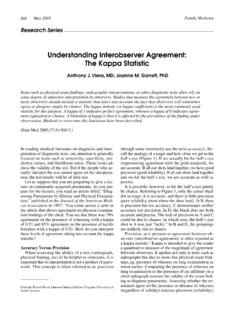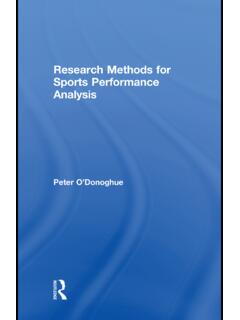Transcription of Inspecting education quality: workbook scrutiny
1 Published: June 2019 Reference no: 190028 workbook scrutiny Ensuring validity and reliability in inspections Her Majesty s Inspectors (HMI) can assess the quality of education by using workbook scrutiny indicators and they do so reliably. The report outlines the findings and the next phase of research. workbook scrutiny June 2019, No. 190028 2 Contents Introduction 3 Methodology 3 Participants 3 Materials 4 Indicators 5 Data collection process 6 Data analysis 6 Research findings 6 Research question 1: Does the piloted approach to book scrutiny allow meaningful assessment of the quality of education ? 6 Research question 2: Can inspectors rate reliably using the piloted book scrutiny indicators? 9 Conclusions and next steps 11 workbook scrutiny June 2019, No. 190028 3 Introduction The focus of inspection under the new framework has shifted to the quality of education more broadly.
2 Some of the evidence inspectors will gather during an inspection under the new education inspection framework (EIF) will feed in to the overarching judgement on the quality of education . For example, conversations with leaders shed light on how curriculum is conceptualised, while lesson observations and workbook scrutiny provide a window into the quality of curriculum implementation. In order to ensure a standard and consistent approach to inspections, we developed and piloted a number of indicators (or assessment criteria). These indicators unpack essential aspects of education in relation to curriculums, teaching and learning. We selected a few of those indicators and further tailored these to workbook scrutiny . This report sets out a recent pilot of indicators and rating scales for workbook scrutiny . We needed to investigate their validity and fitness for purpose, so our first question was: 1.
3 Does the piloted approach to workbook scrutiny allow meaningful assessment of the quality of education ? The study design also included an initial and small-scale exploration of reliability, so we also asked: 2. Can inspectors rate reliably using the piloted workbook scrutiny indicators? The first research question was answered through the findings arising from questionnaire and focus group feedback of the participating HMI. The second one was answered through a statistical analysis of the level of agreement between HMI judgements. Methodology This was a mixed methods study, with the convergent parallel We collected both quantitative and qualitative data to allow a more rounded validation of the piloted indicators and rating scales. This is the first phase of a multi-phase research project. Participants Nine HMI participated in the pilot study. Most of them (n=7) have substantial experience of two to three years or more in the role.
4 Two HMI have one to two years of experience or less. Their subject expertise were in English, mathematics, science, 1 JW Creswell and VL Plano Clark, Designing and conducting mixed methods research , SAGE Publications, 2011. workbook scrutiny June 2019, No. 190028 4 history and geography. They scrutinised workbooks within and outside of their areas of expertise (see Table 1). Table 1: Areas of expertise Areas of expertise Areas outside of specialism HMI 1 English Science HMI 2 English History/geography HMI 3 Mathematics English HMI 4 Mathematics English HMI 5 Science English HMI 6 Science Mathematics HMI 7 History French, science HMI 8 French History/geography HMI 9 French Mathematics Materials We obtained workbooks from primary and secondary schools to ensure that key stages 2 and 3 were represented (see Table 2).
5 The subjects matched the participating HMIs areas of expertise. Table 2: The range of workbooks Subject areas in workbooks Primary Secondary Year 3 Year 4 Year 5 Year 8 Year 9 Mathematics 15 15 15 2 2 English 15 15 15 8 12 History and geography 29 15 15 14 Science 15 15 15 10 15 French 15 15 15 Workbooks in each subject were scrutinised by at least two HMI specialising in the subject. The exceptions with only one subject specialist were history workbooks and primary workbooks for science. The same workbooks were also scrutinised by two or three non-specialist HMI. The exceptions were French workbooks and primary school English workbooks, which were examined by only one non-specialist HMI. The study design of at least two HMI per workbook and subject allowed an initial examination of reliability. workbook scrutiny June 2019, No. 190028 5 Indicators In order to develop the indicators for the EIF, we consulted several HMI and looked at the available research literature.
6 We selected four indicators for workbook scrutiny from a wider range of the indicators designed for the whole inspection process (see Table 3). We drew the workbook scrutiny indicators from the implementation indicators and tailored them further with the following in mind: the aspects of the quality of education described in the indicators should be observable in workbook scrutiny the indicators should cover different aspects of the quality of education , for example: what is taught and learned (the breadth and depth of subject-matter content) how subject matter is taught and learned (from the perspective of how learning is structured to allow for efficient and meaningful acquisition of new knowledge) whether and how pupils consolidate knowledge so that it remains in their long-term memory. Table 3: Book scrutiny indicators selected for the pilot Building on previous learning Depth and breadth of coverage Pupils progress Practice Pupils knowledge is consistently, coherently and logically sequenced so that it can develop incrementally over time.
7 There is a progression from the simpler and/or more concrete concepts to the more complex and/or abstract ones. Pupils work shows that they have developed their knowledge and skills over time. The content of the tasks and pupils work show that pupils learn a suitably broad range of topics within a subject. Tasks also allow pupils to deepen their knowledge of the subject by requiring thought on their part, understanding of subject-specific concepts and making connections to prior knowledge. Pupils make strong progress from their starting points. They acquire knowledge and understanding appropriate to their starting points. Pupils are regularly given opportunities to revisit and practice what they know to deepen and solidify their understanding in a discipline. They can recall information effectively, which shows that learning is durable. Any misconceptions are addressed and there is evidence to show that pupils have overcome these in future work.
8 Each indicator has a five-point rating scale, ranging from 1 (minimum) to 5 (maximum). Each of the five bands in each indicator was accompanied by a descriptor a text which describes the quality of education at a particular level. workbook scrutiny June 2019, No. 190028 6 Data collection process We obtained workbooks from three schools. Nine HMI took turns scrutinising them without discussing their judgements during the exercise. This took place in one of our offices and in a single day. Before starting workbook scrutiny , HMI were given time to familiarise themselves with the four indicators. They then applied the indicators to the workbooks, recording their judgements by year and key stage within the allocated subject areas and providing a rationale for their judgements. Following that, they completed a questionnaire about the indicators and the piloted workbook scrutiny process.
9 Finally, they participated in a focus group interview. This process is different from live inspection. In live inspection, workbook scrutiny is intended to complement conversations with leaders and pupils, as well as lesson observations. The aim in live inspection will be to establish whether the quality of pupils workbooks matches leaders curriculum intent of the curriculum. We could not achieve this in this pilot because the workbook scrutiny took place in isolation, due to practical constraints. Data analysis We collected both qualitative and quantitative data. We obtained the qualitative data through open-ended questions in questionnaires and through a focus group interview with HMI. We then identified the main and recurrent themes. We obtained some quantitative data through fixed-choice questions in the feedback questionnaire. Judgements awarded for each subject and year group also constitute quantitative data: they were marked on a 1- to 5-point scale.
10 In order to assess reliability, we used Cohen s kappa as the statistic to measure agreement between each two raters (HMI) who rated the same books using our indicators. The kappa coefficient is applicable for categorical or ordinal data. It is generally seen as a stronger measure than a simple percentage agreement calculation . This is because it takes into account whether the agreement reached has occurred by chance. Research findings Research question 1: Does the piloted approach to book scrutiny allow meaningful assessment of the quality of education ? The general finding derived from HMI feedback is that the piloted indicators are a step in the right direction. They helped HMI focus on the essential aspects of the quality of education , while minimising the effect of irrelevant factors such as workbook scrutiny June 2019, No. 190028 7 neatness or handwriting.














